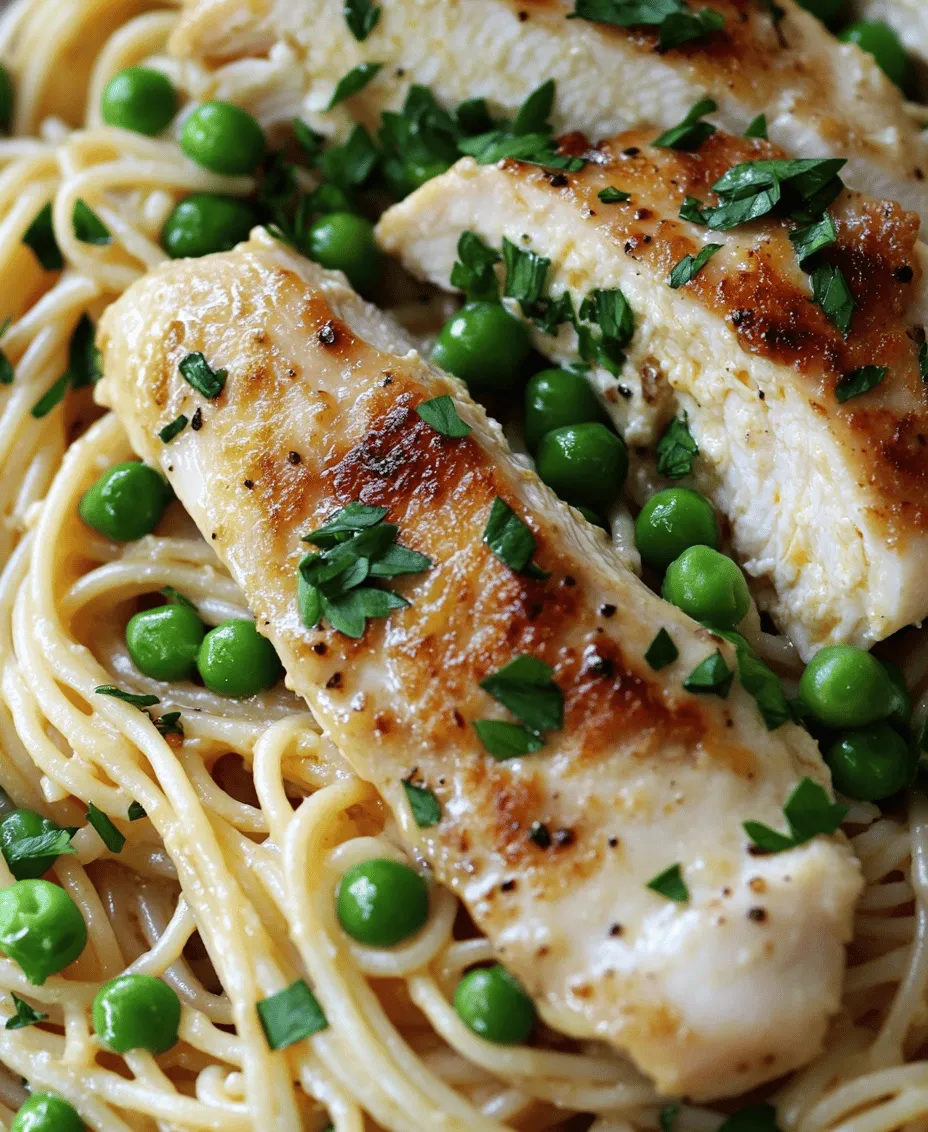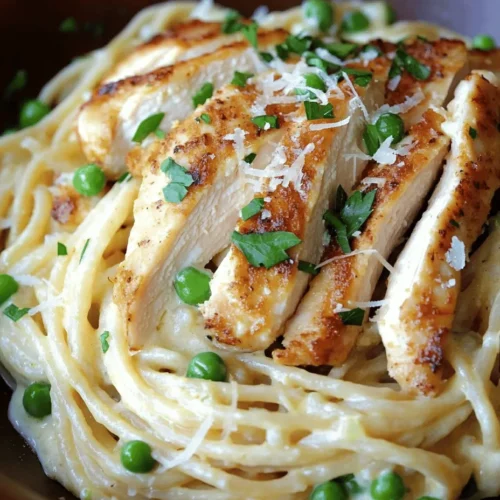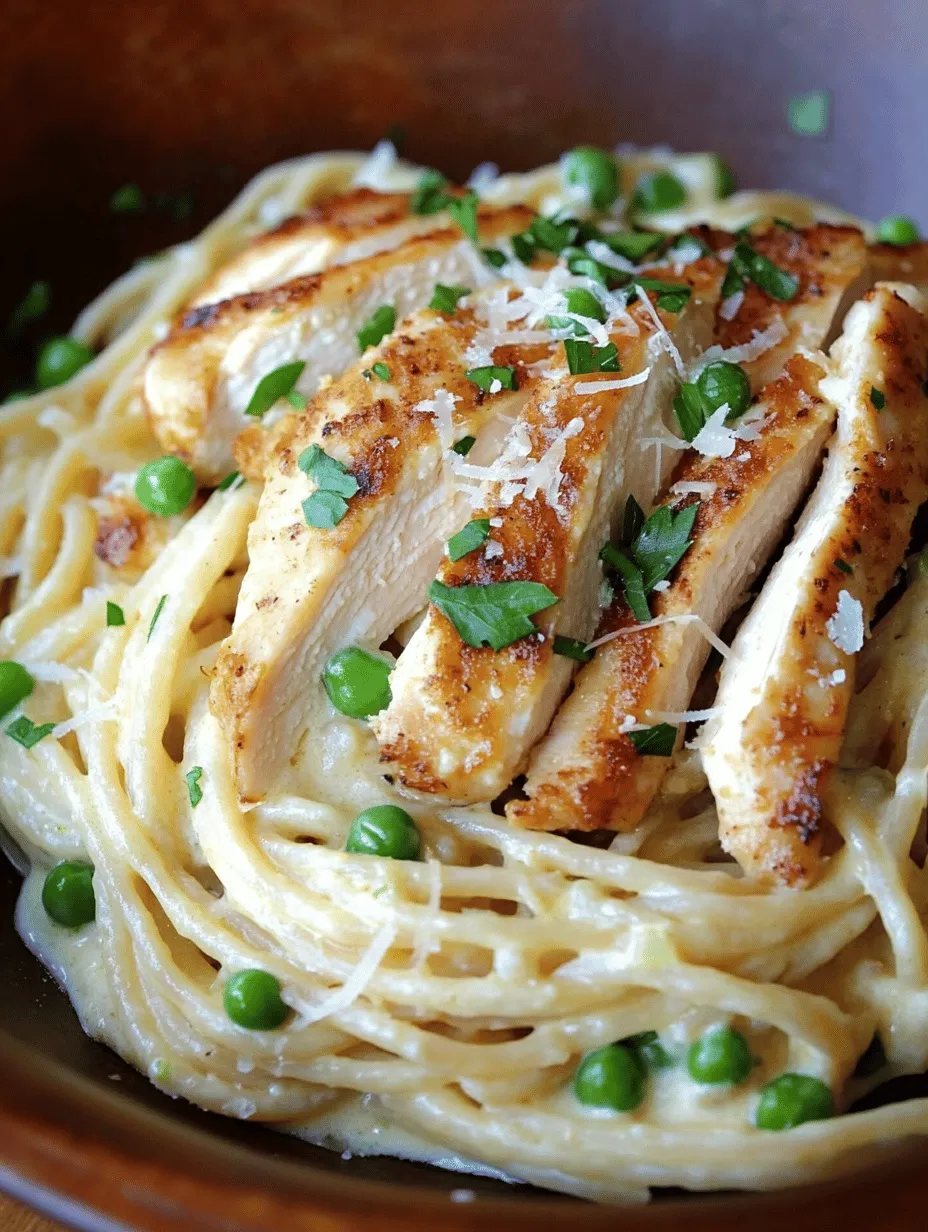In the world of comfort food, few dishes rival the creamy, savory goodness of Chicken Carbonara. This delightful pasta dish combines tender chicken, al dente spaghetti or fettuccine, and a luscious sauce made from eggs, Parmesan cheese, and heavy cream. With its rich flavors and irresistible aroma, Chicken Carbonara is not only a treat for the taste buds but also a feast for the senses. Perfect for a weeknight dinner or a special occasion, this recipe is sure to become a family favorite. In this article, we will delve into the origins of Carbonara, the essential ingredients that make this dish shine, and provide a step-by-step guide to creating the best-ever Chicken Carbonara right in your own kitchen.
The Origins of Carbonara
Exploring the History of Carbonara
Carbonara is a classic Italian pasta dish that has captured the hearts of food lovers around the globe. Though its exact origins are somewhat murky, it is widely believed that the dish hails from the Lazio region of Italy, particularly Rome. The name “Carbonara” is thought to derive from “carbone,” which means “coal” in Italian, potentially referring to the coal workers who would prepare this hearty meal. The dish is said to have been a staple among these laborers, providing them with the necessary energy to fuel their demanding work.
While the precise history of Carbonara is debated, one widely accepted theory traces its roots back to the mid-20th century, around World War II. It’s said that American soldiers stationed in Italy during the war were introduced to the local cuisine, and they adapted an existing Italian recipe using ingredients that were readily available to them, such as bacon, eggs, and cheese. Over time, this evolved into the creamy Carbonara we know today, with various adaptations emerging across the world.
Understanding the Italian Culinary Tradition
Italian cuisine is famed for its simplicity, relying heavily on high-quality ingredients that shine through in each dish. Traditional Italian cooking often emphasizes the importance of regional specialties and seasonal produce. Carbonara is a fine example of this culinary philosophy, as it showcases a few key ingredients that, when combined, create a dish bursting with flavor.
In Italy, it is common to see variations of Carbonara based on local preferences and available ingredients. While traditional Carbonara typically features guanciale (cured pork cheek), eggs, Pecorino Romano cheese, and black pepper, the addition of chicken and cream in our recipe provides a modern twist that enhances the dish’s richness and makes it accessible to a wider audience.
Differences Between Traditional and Modern Carbonara
The traditional Roman version of Carbonara is known for its simplicity and bold flavors, often eschewing cream in favor of the emulsion created by eggs and cheese. However, as culinary traditions evolve, so do the recipes that accompany them. Modern interpretations of Carbonara frequently incorporate cream for added richness and a more luxurious texture. Additionally, chicken is a popular option for those seeking a leaner protein source while still retaining the comforting essence of the dish.
In our Best-Ever Chicken Carbonara recipe, we embrace this modern variation, creating a dish that is both indulgent and satisfying while remaining true to the spirit of Italian cooking.
Essential Ingredients for the Best Chicken Carbonara
Creating the best-ever Chicken Carbonara requires attention to detail, especially when it comes to selecting the right ingredients. Here, we provide an overview of the key components that will elevate your Chicken Carbonara from ordinary to extraordinary.
Pasta Choices: Spaghetti vs. Fettuccine
When it comes to pasta for Carbonara, the most traditional choice is spaghetti, a long, thin noodle that captures the creamy sauce beautifully. However, fettuccine, with its wider ribbon-like structure, can also be a fantastic option, providing a heartier bite that complements the dish’s richness. Ultimately, the choice between spaghetti and fettuccine comes down to personal preference, and both options will yield delicious results.
The Role of Chicken in Carbonara
In our Chicken Carbonara recipe, tender pieces of chicken take center stage, providing a lean protein source to balance the creamy sauce. Chicken breast is typically used for its mild flavor and quick cooking time; however, you can also opt for chicken thighs for a juicier and more flavorful alternative. Regardless of the cut you choose, be sure to season the chicken well to enhance its taste further.
The Importance of Fresh Garlic
Garlic is an essential ingredient in many Italian dishes, and Chicken Carbonara is no exception. Fresh garlic adds a fragrant aroma and depth of flavor to the sauce. When sautéed, garlic becomes sweet and mellow, perfectly complementing the richness of the cream and cheese. For the best results, use fresh garlic cloves and mince them just before cooking to preserve their flavor and potency.
Eggs: The Heart of the Sauce
At the heart of any Carbonara is a rich and creamy sauce made from eggs. In our Chicken Carbonara recipe, we recommend using large eggs, which will help create a luscious consistency. As the pasta is tossed with the hot noodles, the residual heat will gently cook the eggs, creating a velvety sauce that clings to each strand of pasta without scrambling.
Choosing the Right Cheese: Parmesan
Cheese is another critical component of a great Chicken Carbonara. While traditional recipes often call for Pecorino Romano, we recommend using freshly grated Parmesan cheese for its nutty and slightly sweet flavor. Freshly grated cheese will melt beautifully into the sauce, creating a creamy texture that enhances the overall dish. Avoid pre-grated varieties, as they often contain anti-caking agents that can affect the sauce’s creaminess.
Creaminess Factor: The Role of Heavy Cream
While purists may argue against the use of cream in traditional Carbonara, adding a splash of heavy cream can elevate the dish’s richness and create a luxurious texture. The cream not only adds flavor but also helps bind the sauce, ensuring it coats the pasta evenly. When incorporating cream into your Chicken Carbonara, be mindful of the quantity—just enough to achieve the desired consistency without overwhelming the other flavors.
Adding Color and Flavor with Peas
To bring a pop of color and a touch of sweetness to your Chicken Carbonara, consider adding fresh or frozen peas. These bright green gems not only enhance the visual appeal of the dish but also provide a delightful contrast to the creamy sauce. As the peas cook, they soften and mingle with the other ingredients, adding a burst of freshness to each bite.
Spicing It Up: The Use of Red Pepper Flakes
For those who enjoy a hint of heat, red pepper flakes are a welcome addition to Chicken Carbonara. A sprinkle of red pepper flakes can elevate the dish, providing a subtle kick that balances the richness of the sauce. Adjust the amount to your taste preference, starting with a pinch and adding more if desired.
Step-by-Step Guide to Preparing Chicken Carbonara
Now that we’ve explored the origins and essential ingredients of Chicken Carbonara, it’s time to dive into the step-by-step process of preparing this delectable dish. Follow these instructions carefully for a flawless outcome.
Cooking the Pasta to Perfection
1. Boil Water: Start by filling a large pot with water and bringing it to a rolling boil. Season the water generously with salt; it should taste like the sea. This seasoning is crucial for flavoring the pasta.
2. Add the Pasta: Once the water is boiling, add your choice of pasta—spaghetti or fettuccine. Stir occasionally to prevent the pasta from sticking together.
3. Cook Al Dente: Follow the package instructions for cooking time, typically around 8-12 minutes, depending on the pasta type. For the best texture, aim for al dente—cooked but still firm to the bite.
4. Reserve Pasta Water: Before draining the pasta, reserve about a cup of the starchy pasta water. This liquid will be invaluable for adjusting the sauce’s consistency later on.
5. Drain the Pasta: Drain the pasta in a colander, but avoid rinsing it, as the starch helps the sauce adhere to the noodles.
Preparing the Chicken: Tips for Tenderness
1. Season the Chicken: While the pasta cooks, prepare the chicken. Season boneless, skinless chicken breasts or thighs with salt, pepper, and any additional spices you prefer.
2. Sauté the Chicken: Heat a large skillet over medium heat and add a drizzle of olive oil. Once the oil is shimmering, carefully place the chicken in the skillet. Cook for about 5-7 minutes per side, depending on the thickness, until the chicken is golden brown and cooked through. Use a meat thermometer to ensure the internal temperature reaches 165°F (75°C).
3. Rest and Slice: Once cooked, transfer the chicken to a cutting board and let it rest for a few minutes. This resting period allows the juices to redistribute, ensuring tender and juicy chicken. After resting, slice the chicken into bite-sized pieces.
Sautéing Garlic: Achieving the Right Aroma
1. Sauté Garlic in the Same Skillet: In the same skillet used to cook the chicken, add a little more olive oil if needed and reduce the heat to low. Add minced garlic and sauté for about 30 seconds, stirring constantly, until the garlic is fragrant but not browned. Be careful not to burn the garlic, as it can turn bitter.
Creating the Creamy Sauce: Whisking Techniques
1. Prepare the Egg Mixture: In a mixing bowl, whisk together the eggs, grated Parmesan cheese, heavy cream, and a pinch of salt and pepper. Whisk until well combined and smooth.
2. Combine with Pasta: Return the drained pasta to the skillet with the sautéed garlic, stirring to coat the noodles in the fragrant oil. Remove the skillet from the heat to prevent the eggs from scrambling when added.
3. Add the Egg Mixture: Quickly pour the egg and cheese mixture over the pasta, tossing vigorously to combine. The residual heat from the pasta will cook the eggs gently, creating a creamy sauce. If the sauce is too thick, add reserved pasta water a little at a time until you reach your desired consistency.
4. Incorporate Chicken and Peas: Add the sliced chicken and peas to the pasta, tossing everything together until well combined.
As you navigate through these steps, your kitchen will begin to fill with the tantalizing aromas of garlic, cheese, and chicken, signifying that you are on your way to creating the best-ever Chicken Carbonara. The next part of our article will delve deeper into a few essential tips for achieving the perfect Carbonara and answer some common questions related to this beloved dish. Stay tuned!

Combining Ingredients for the Perfect Texture
Achieving the perfect texture in Chicken Carbonara is crucial for creating that creamy, rich consistency without overcooking the ingredients. Start by ensuring that your pasta is al dente. This means it should be cooked through but still firm to the bite. When you drain the pasta, make sure to reserve about one cup of the starchy pasta water. This water is a game-changer when it comes to emulsifying the sauce and achieving that silky texture.
Once your pasta is ready, it’s time to combine it with the other ingredients. Start by adding the cooked chicken pieces to the pasta in a large mixing bowl. Then, drizzle in the creamy sauce made from eggs, Parmesan cheese, and freshly cracked pepper. The key to achieving that smooth, velvety sauce is to mix everything quickly and gently. This prevents the eggs from scrambling and ensures they coat each strand of pasta evenly. If the mixture appears too thick, gradually incorporate the reserved pasta water, a little at a time, until you reach your desired consistency.
Serving Suggestions: Presentation Ideas
Presentation can elevate your Chicken Carbonara from a simple meal to a restaurant-quality dish. Here are some ideas to make your Carbonara visually appealing:
1. Plating: Use a large, shallow bowl or a deep plate to serve your Carbonara. Twirl the pasta into a nest shape using a fork or tongs for a sophisticated look.
2. Garnishing: Top the dish with freshly grated Parmesan cheese and a sprinkle of chopped parsley for a pop of color. A few cracks of black pepper can add a nice finishing touch.
3. Additional Ingredients: Consider adding crispy pancetta or bacon on top for a delightful crunch. You can also incorporate a soft-boiled egg, which adds richness and a beautiful visual element when cut open.
4. Serving Temperature: Serve the Carbonara immediately while it’s still warm. This ensures that the sauce remains creamy and the flavors are at their peak.
Nutritional Information of Chicken Carbonara
Understanding the nutritional content of your Chicken Carbonara can help you enjoy this dish while being mindful of your dietary needs.
Caloric Breakdown per Serving
A typical serving of Chicken Carbonara (approximately 1 cup) contains around 550-600 calories. This caloric breakdown can vary based on portion sizes and specific ingredients used. Here is a general overview:
– Carbohydrates: 60-70g
– Protein: 30-35g
– Fats: 20-25g
Health Benefits of Key Ingredients
– Chicken: A lean source of protein, chicken breast is low in fat and high in essential nutrients like niacin and phosphorus.
– Eggs: Rich in protein and healthy fats, eggs also provide choline, which is vital for brain health.
– Parmesan Cheese: This cheese is a good source of calcium and protein, and its strong flavor allows you to use less while still enjoying a rich taste.
– Pasta: Whole grain pasta can offer fiber, which aids digestion and supports heart health.
Balancing Comfort Food with Nutrition
While Chicken Carbonara is undeniably a comfort food, it can be made healthier by using whole-grain pasta, reducing cheese portions, and incorporating additional vegetables like spinach or peas. These modifications maintain the dish’s comforting essence while enhancing its nutritional profile.
Common Mistakes to Avoid When Making Carbonara
To ensure your Chicken Carbonara turns out perfectly every time, be aware of these common pitfalls.
Overcooking the Pasta
One of the biggest mistakes home cooks make is overcooking the pasta. Always follow the package instructions and taste the pasta a minute or two before the suggested cooking time. Remember, it should be al dente, as it will continue to cook slightly when mixed with the sauce.
Burning the Garlic: How to Prevent It
Garlic can burn quickly, leading to a bitter taste in your Carbonara. To prevent this, cook the garlic on low heat and stir frequently. If you notice it beginning to brown too much, remove it from the heat immediately to avoid burning.
Getting the Sauce Just Right: Avoiding Scrambled Eggs
The most critical aspect of a successful Carbonara is ensuring that the eggs create a creamy sauce rather than scrambling. To achieve this, remove the pasta from the heat before adding the egg mixture. The residual heat will cook the eggs gently. Stir quickly to combine, and add reserved pasta water as needed to achieve a creamy texture.
Choosing the Wrong Cheese
Using the wrong cheese can alter the flavor and texture of your Carbonara. Stick with aged Parmesan or Pecorino Romano for the best results, as their sharp, salty flavor complements the dish beautifully.
Variations on the Classic Chicken Carbonara
Get creative with your Chicken Carbonara by trying out these delicious variations.
Exploring Other Protein Options: Bacon, Shrimp, or Tofu
While chicken is the star of this recipe, you can easily substitute other proteins. Crispy bacon or pancetta adds a smoky flavor, while shrimp can provide a lighter seafood twist. For a vegetarian option, try using firm tofu. Simply sauté tofu cubes until golden and mix them in with the pasta.
Vegetarian Alternatives: Substituting Chicken
If you want to make a vegetarian Carbonara, consider using sautéed mushrooms in place of chicken. They add an earthy flavor and meaty texture that pairs well with the creamy sauce.
Flavor Enhancements: Using Different Herbs and Spices
Don’t be afraid to experiment with flavors. Adding fresh herbs like basil or thyme can elevate the dish, while a pinch of red pepper flakes can introduce a delightful heat. Consider incorporating lemon zest for a refreshing touch.
Pairing Suggestions for Chicken Carbonara
To enhance your Chicken Carbonara experience, consider these pairing suggestions.
Wine Pairings: Best Wines to Complement the Dish
A rich and creamy dish like Chicken Carbonara pairs well with white wines. Opt for a crisp Pinot Grigio or a buttery Chardonnay. Both wines can balance the richness of the sauce and complement the flavors of the chicken and cheese.
Salad and Side Dish Suggestions
A light salad can provide a refreshing contrast to the creamy Carbonara. A simple arugula salad dressed with lemon vinaigrette works beautifully. Additionally, roasted vegetables or garlic bread can serve as great side dishes.
Dessert Ideas to Complete the Meal
To finish your meal on a sweet note, consider serving a light dessert. A classic panna cotta or a fruit sorbet can cleanse the palate after the rich Carbonara.
Conclusion
Chicken Carbonara is more than just a meal; it’s a comforting dish that evokes warmth and satisfaction. By understanding the origins, ingredients, and techniques involved in creating this classic recipe, you can elevate your cooking skills and delight your loved ones with a dish that is both simple and sophisticated. With the right approach, your Chicken Carbonara can be the star of any dinner table, providing a delicious experience that will keep everyone coming back for more. So gather your ingredients, follow these tips, and enjoy the process of creating this beloved Italian classic. Bon Appétit!



